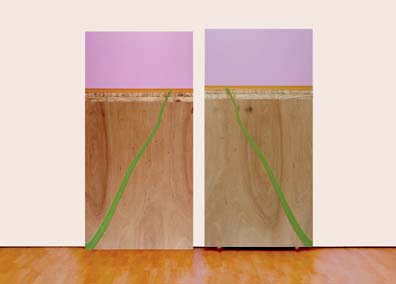

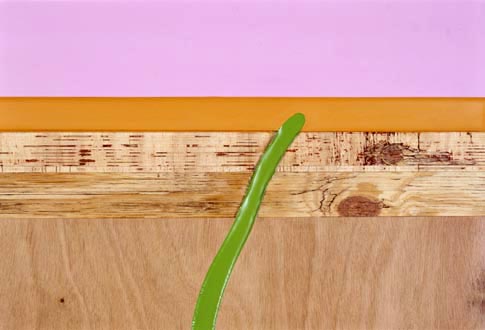
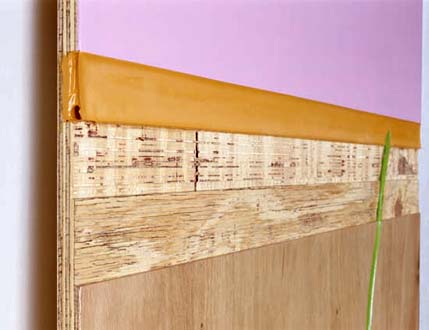
Picca
has stated that we might be ‘tourists in our own environment.’ On
a theoretical level, this rather anxious statement implies an endless circulation
among the illusions of ‘center’ both metaphysical and cultural,
spaces forever sanitized and cleansed for our consumption. We call on the
Generic to be the guiding factor in the processes of collective recognition,
a mark in which to stabilize identity. In practice these paintings attempt
to reproduce those generic illusions via various means and modest fantasies.
His paintings operate as tourists of certain cultural landscapes, exploring
these different territories, adopting (momentarily) their critical positions
so as to let them merge and conflict.
Once condemned to its own trajectory of progress, painting has (hopefully) long since relinquished this fate. Direct and economical, Untitled ventures near but is by no means motivated entirely by Modernist principals of refinement, similarly Untitled as a ‘tourist’ harbors fantasies of doing the ‘Grand Tour’ of High Modernism and then ‘slumming it’ with more prosaic modes of production, even this dialectic quickly became the standardised subject requirement for any legitimate account of Painting, ultimately as Picca demonstrates, these accounts can continue to maintain a currency without becoming dogmas, resisting the endless pendulum swing of ‘correct’ critical manoeuvering. The work both navigates and avoids these terrains, presenting combinations of precise juxtapositions between surface, figure, colour fields and so on which seek to activate more complex spatial and narrative exchanges, irreducible to simple oppositional strategies or critical paradigms.
A preoccupation of the work is perhaps the culture of Wood. Picca occupies the methodologies and procedures of DIY, Woodcarving and Painting, Wood here is left alone, chopped, excavated, sawn, dressed up in varnish or left resplendent in all its splintered charms. The DIY enthusiast may be relegated to a Sunday activity, but he/she is charged with latent desires to effect a utopian social order. One that conforms to the rigorous model hypothesised by out of town furniture and home improvement stores. Of course this ‘order’ will always function on the exclusion of other parties, the codes of lifestyle exclusivity permeate all forms of cultural activity and the processes of assimilation will flatten out even the most stubborn of gestures. Painting amongst other modes of practice can at least make stubbornness some sort of virtue. Unconstrained by the ‘tyranny’ of finish which conditions the craftsmen or designer, the painter may explore the accidents and effects which oppose any immediate consumption of its own meaning. For Picca, he leaves us with surfaces that would induce insomnia for the DIY enthusiast, at times treating the materiality of wood as though it possessed the malleability of paint.
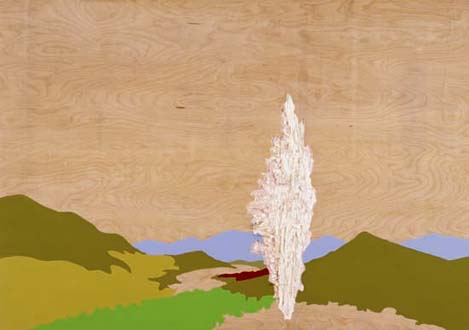
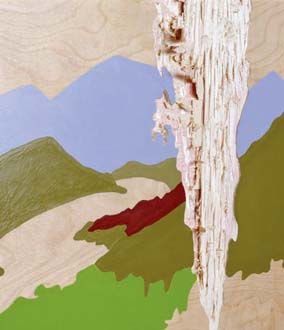
The procedures
employed can involve a meticulous attention to detail. A line, which conveys
all the vulnerability of the hand, has been realized by the power tool. Carving
into the wood, additions are made through the process of removal. We are left,
in some instances with the feeling that a calculated theft has taken place,
leaving within the picture, vacant spaces that perform ambiguous descriptive
functions. On closer inspection these reveal textures and incidents that behave
in the way paint can, disengaging itself from the divisions of labour to simply
‘be paint.’ In these paintings, this is wood describing wood, the
wood of ‘the tree’ or left alone to be ‘itself’ - a product
of the timber yard.
Painting has its limits. Even when occupying the margins of other practices, digital or sculptural, we still rely on the interpretative tools as before, albeit slightly modified. We can’t make demands of the painter to make explicit articulations of cultural change. The lyrics might be contemporary but painting will still operate ‘acoustically’. Picca takes pleasure in the testing of these limits with the hybrid methods he uses, irony exists, but is a component of, rather than integral to the work. The careful attention that he gives in the construction of the work suggests a belief in the transformative power of those methods. Even after schematizing the pre-capitalist ideals of a Romantic landscape, using the latest ‘Interiors’ range from Dulux so as to enact on the surface some pre-industrial Craftwork. On paper, we could close down meaning here and submit it to a ‘critical correctness’ of the driest order, but for his paintings these would be unconvincing limits, working with the constraints of being ‘knowing’ but taking pleasure in the liberal exchange of methods, we inhabit spaces that encourage moments of wilful longing while prodding us with the realities of our ‘armchair’ fantasies.